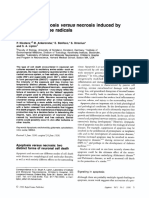Apoptosis Versus Necrosis: March 2018
Apoptosis Versus Necrosis: March 2018
Uploaded by
Gandhis Apri WidhayantiCopyright:
Available Formats
Apoptosis Versus Necrosis: March 2018
Apoptosis Versus Necrosis: March 2018
Uploaded by
Gandhis Apri WidhayantiOriginal Title
Copyright
Available Formats
Share this document
Did you find this document useful?
Is this content inappropriate?
Copyright:
Available Formats
Apoptosis Versus Necrosis: March 2018
Apoptosis Versus Necrosis: March 2018
Uploaded by
Gandhis Apri WidhayantiCopyright:
Available Formats
See discussions, stats, and author profiles for this publication at: https://www.researchgate.
net/publication/323547806
Apoptosis versus necrosis
Article · March 2018
CITATION READS
1 1,753
1 author:
Tim Sandle
The University of Manchester
630 PUBLICATIONS 946 CITATIONS
SEE PROFILE
Some of the authors of this publication are also working on these related projects:
Helminths of wild animals View project
Pharmaceutical product recalls View project
All content following this page was uploaded by Tim Sandle on 04 March 2018.
The user has requested enhancement of the downloaded file.
Tim Sandle, SFJ Chro Dis, 2018, 1:1
SciFed Journal of Chronic Diseases
Mini Review Open Access
Apoptosis versus Necrosis
*1
Tim Sandle, 2Antonella Chesca, 3Ardak Sekenovna Akhayeva, 3Alexandr Borisovich Marchenko
*1
University of Manchester, United Kingdom
2
Transilvania University of Brasov, Clinical Hospital of Pneumophtysiology Brasov, Romania
3
Karaganda State Medical University, Kazakhstan
Introduction characterized by dystrophic to irreversible cell damage;
This article examines the different characteristics here the cells are "dying" during which catabolic processes
between apoptosis and necrosis, two morphologically prevail compared with the anabolic. The last and final
distinct manifestations of cell death. Necrosis is non- stage, called necrosis itself, is characterized by disruption
genetic and triggered by external forces, such as trauma or of vital cell as a biological system [3].
infection; whereas is apoptosis is a genetically programmed Stage IV is referred post-necrosis, and this is
type of cell death. Understanding this difference is not characterized by the disintegration of the autolysis and cell
straightforward, yet interpreting the difference is essential processes occurring by the action of lysosomal enzymes and
for medics in order to deliver the optimal treatment the generation of its own inflammatory response. In terms
regime. Apoptosis rarely requires medical intervention; of biomolecular alterations, necrosis characteristically
however, necrosis always requires medical treatment. occurs by inflating the cells and organelles, including
Untreated necrosis is dangerous and can lead to death, and expansion of early changes in conformation mitochondria
it is therefore of considerable medical concern. and also in their functions. In this context necrosis usually
occurs by cell plasmolysis. This occurs due to excessive
Comparing Apoptosis and Necrosis water penetration into the cell, leading to plasma membrane
Necrosis describes the process of cell death, lysis. Necrosis begins with changes in the cytoplasm and
a phenomenon that occurs in a certain locale within the mitochondria swelling and ends with lysis of cells together
living organism. Necrosis can occur accidentally with the with total disintegration of organelles [4].
outcome being disorganized and destructive, affecting one Studies have shown that cellular changes occur
or more cells. The process occurs due to various external as the adenosine triphosphate (ATP) levels are depleted
factors like infection, toxins, or trauma. Biologically these and transmembrane ion gradient dissipates [5]. The cell
are manifest in a haphazard way [1]. From this perspective, membrane can become a major site of disruption, with
changes that could induce necrosis in a given territory at membranes losing their ability to control osmotic pressure;
the level of a living organism are primarily connected with as a result of these processes, the cell can swell and crack.
the occurrence of injuries. Severe cell damage can occur
suddenly; such as sometimes being caused by ischemia or
hyperthermia following a physical and chemical trauma. In
this context necrosis can be considered as a type of cellular *Corresponding author: Tim Sandle, University of Manchester, United
metabolic collapse, something that occurs when cells Kingdom. E-mail: timsandle@btinternet.com; Tel: 07808906409
can no longer maintain ion homeostasis (the asymmetric Received February 7, 2018; Accepted Febryary 13, 2018; Published
concentrations of the major inorganic cations and anions is February 23, 2018
a major function of cellular membranes) [2]. Citation: Tim Sandle (2018) Apoptosis versus Necrosis. SFJ Chro Dis.
Necrosis takes place following several stages
that occur in succession. In the first stage, pre-necrosis, Copyright: © 2018 Tim Sandle. This is an open-access article distributed
under the terms of the Creative Commons Attribution License, which permits
this is characterized dystrophic changes by reversible unrestricted use, distribution, and reproduction in any medium, provided the
cell damage. In the next stage, termed necrobiosis, this is original author and source are credited.
SFJ Chro Dis Volume 1 · Issue 1 · 1000001
ISSN:xxxx-xxxx SFJCD, an open access journal page 1 of 4
Citation: Tim Sandle (2018) Apoptosis versus Necrosis. SFJ Chro Dis.
The damage to internal membranes can allow for the in necrosis. In this sense, apoptosis occurs in scattered
release of lysosomal enzymes, which, in turn, release individual cells and groups of cells that are not adjacent,
the cell contents into the extracellular space. This causes unlike what typically occurs happens with necrosis [7].
a nonspecific inflammatory response. Necrosis is also There are several possible mechanisms for the recognition
characterized by random digestion of DNA with DNA of apoptotic cells by phagocytes, with cells displayed as
fragmentation after lysis. apoptotic target statuses. Although apoptosis is a process
During necrosis, cell nuclei undergo changes that differs to necrosis, representing the physiological
termed karyopyknosis, this means nuclei become pyknotic pathway of cell death, apoptosis can also be caused
(the irreversible condensation of chromatin in the nucleus by pathological stimuli where apoptosis is develops
of a cell) and become fragmented into blocks. This is the necessary energy in the form of ATP [8]. Unlike
followed by changes termed karyolysis, which is the with necrosis, apoptosis cannot communicate with the
complete dissolution of the chromatin of a dying cell due series of metabolic events that invariably occur during
to the enzymatic degradation by endonucleases. the development of the process. The ATP issue is of
Hence it can be concluded that necrosis is defined importance, since classic apoptotic triggers can be changed
as unplanned process of cell death that is triggered by from apoptosis to necrosis, when cells are pre-emptied of
factors not under the control of the body. Contrary to ATP.
necrosis, which is programmed cell death and genetically With apoptosis, from the biochemical point of
independent, apoptosis is a genetically programmed view, in the cell the reduction of the synthesis of RNA
cell death where certain biochemical events lead to and protein is followed by degradation [5]. Initially it was
characteristic cell morphology changes and death. Such thought that the transition from normal to apoptotic is a fast
programmed cell death process can be activated by process. However, contraction that cannot be observed in
intracellular genetically defined development program an intermediate state using flow cytometry and cell sorting
and through the extracellular endogenous proteins or can lead to observations on the order discerning apoptotic
cytokines; or, alternatively, hormones with xenobiotic events. Further, intimacy events of apoptosis have been
components, radiation, hypoxia, or oxidative stress. studied using the technique PFGE (pulsed field gradient
The most important elements of apoptosis are gel electrophoresis) [3].
the activities of caspases (the family of protease enzymes From another perspective, a considerable number
that play an essential role in programmed cell death); here of mutations affecting specific stages of the process of
apoptosis morphological expression is represented by apoptosis have bene identified. Further, corresponding
apoptotic bodies. Apoptosis occurs in two circumstances, genes have been identified for specific mutations, and
namely in normal tissues where cells responsible for these are ordered in a genetic map. On this basis, the events
deletion and certain pathologies. In contrast pathological of apoptosis have been extensively studied. Research
necrosis, apoptosis is always the consequence of a major results have shown that the genes that make up the map of
cellular damage [1]. Early in the process there is a apoptosis specific mutations are involved in the decision
sustained increase in cytosolic ionized calcium levels in to enter the programmed cell death pathway. The results
many cell types [2]. of these studies reveal that genes ced-3 and ced-4 are
Cross-linking occurs in the cytoplasm protein, a required for all forms of apoptosis and they are involved in
process that takes place by the action transglutaminases. the apoptotic pathways that encode end-effectors [9].
In this process, cytoskeletal filament aggregation also The cell death abnormality gene 9 (Ced-9) is
occurs in parallel formations. Moreover, the endoplasmic useful for suppressing (or inhibiting) apoptosis in cells
reticulum expands and merges with the plasma membrane, programmed to survive; from this point of view the gene
creating fusion craters at sacciform (‘bag’ or ‘sac’) shape is considered as a key regulatory gene. It seems that the
[6]. Further with apoptosis, the cell membrane specific genes mentioned, either in whole or in part, are involved in
modifications that occur consist of swelling, to a greater encoding a protein homologous to Bcl-2 family of human
extent compared to the types of changes that occur with system. Hence it is believed that the expression of Bcl-2
necrosis [4]. may be involved in inhibiting apoptosis in certain species
Hence apoptosis refers to morphological changes of primate, or even where a partial loss of function could
that occur during the process that defines cell death, be substituted by Ced-9. This would indicate that at least
including specific changes, other than those appearing some components of the apoptotic pathway are conserved
SFJ Chro Dis Volume 1 · Issue 1 · 1000001
ISSN:xxxx-xxxx SFJCD, an open access journal page 2 of 4
Citation: Tim Sandle (2018) Apoptosis versus Necrosis. SFJ Chro Dis.
in evolution. and burst, spilling their contents and causing a damaging
Other research results suggest that mutations occur inflammatory response, as with cell necrosis.
in six genes affecting apoptotic bodies by embedding non- However, apoptosis can sometimes be advanced in the
professional neighboring cells. Here it has been observed body for multiple reasons. One example is with cancer.
that intracellular proteins Ced-2, Ced-5 and Ced-10 Here the typical functioning of cellular pathways becomes
signal in a manner comparable to their counterparts in disrupted to the degree this impairs the ability of a cell
mammalian Crkll, DOCK 180, and cancer, are involved to undergo normal apoptosis. Hence the cell continues
in mediating in the reorganization and in included cell beyond its typical life and it can thus replicate and pass
of cytoskeleton extension. Ced-7, homologous ABC-1 on its faulty machinery to its progeny [11]. This enhances
activates both cell and in the dying included cell, possibly the possibility of cells becoming cancerous. A second
in the transmembrane transport of lipids. Data also suggests example arises from viral infections, such as the Human
the presence of Ced-1 analog scavenger receptors in the Immunodeficiency Virus or other viruses, such as canine
mammalian system; with these, Ced-7 and Ced-1 promote, distemper virus or the oropouche virus.
and probably embed, interacting protein Ced-6 signaling
adapters. Summary
This article has considered the differences between
Examples of Necrosis and Apoptosis necrosis and apoptosis, for the purposes of increasing
Medical doctors need to understand the difference medical understanding. Necrosis occurs when cells are
between necrosis and apoptosis because of the different exposed to a variance away from ideal physiological
medical responses required. When cells die by apoptosis, conditions, leading to damage to the cell plasma membrane.
inflammation does not occur; with necrosis, the cell As the membrane is damaged, cytoplasmic contents, like
membrane is ruptured and the released cell content causes lysosomal enzymes, can be released into the extracellular
a significant inflammatory response. fluid. In contrast, apoptosis is a mode of cell death that
Hence understanding the differences between happens under normal physiological conditions, being part
necrosis and apoptosis can assist the medic in assessing of normal cell turnover.
different medical conditions. Medical researchers also In drawing out these cell-death differences in
need to understand the differences, since this contributes this paper, more recent research has been highlighted.
to research that seeks to ensure human body cells do not Assessing these two phenomena is of importance given that
trigger cell death too soon or too late. Such research can virtually all cell deaths can be classified dichotomously as
contribute to our understanding of controlling diseases. either apoptosis or necrosis. This aids the medical doctor
Conditions relating to necrosis can be divided into in making the correct decision in relation to a patient.
external and internal factors. Some external cases include Many thanks to Professor Joop van Zoelen,
mechanical trauma, such as physical damage to the body Radboud University Nijmegen NL.
that triggers cell breakdown. One example is from the
bites of certain spiders. A second external factor arises References
from damage to blood vessels (affecting blood supply to 1. Antonella Cheşcă, Simona Marcu, Mariana Tilinca (2010)
tissues); and ischemia [10]. In addition, variations with Esenţialul în Biologie Celulară şi Histologie Generală - pentru
heat, such as extremely high or low temperature, can facultăţi de medicină şi asistenţă medicală. Editura Universităţii
cause thermal disruption, which can also trigger necrosis. “Transilvania” din Braşov Editură recunoscută CNCSIS 1-350.
An example is with the result of frostbite. Internal factors
leading to necrosis include trophoneurotic disorders or 2. Sinteze, Antonella Cheşcă, Mariana Cornelia Tilinca
(2009) Biologie celulară şi moleculară. Editura Universităţii
injury and paralysis of nerve cells.
“Transilvania” din Braşov, Editură recunoscută CNCSIS 1-177.
With apoptosis, as discussed earlier, this is a
highly regulated and controlled process. Normal apoptosis 3. Antonella Cheşcă, Melek Öztürk (2011) Methods for Cellular
is a part of life; cells that die typically do so neatly, without and Molecular Diagnostics in Human Pathology, Istanbul
any adverse impact on neighboring cells. Classic example University Press House 1- 156. Introductive Notions and general
of apoptosis is during embryogenesis, when skin cells Data of Cellular and Molecular Biology, Antonella Cheşcă,
forming a web between fingers are destroyed. This process Faculty of Medicine “Transilvania” University of Brasov
contrasts with acute injury, where cells typically swell Romania 1-12.
SFJ Chro Dis Volume 1 · Issue 1 · 1000001
ISSN:xxxx-xxxx SFJCD, an open access journal page 3 of 4
Citation: Tim Sandle (2018) Apoptosis versus Necrosis. SFJ Chro Dis.
4. Techniques and Procedures for Diseases Diagnostic (2014),
Edited by, Lambert Academic Publishing, book and e-book 1-
124.
5. E-Book (2013) Modern Diagnostic Methods for Human
Diseases, Edited by Antonella Cheşcă, Co-editor Melek Öztürk,
Istanbul University Press House.
6. Tamas Koszegi, Antonella Cheşcă (2015) Laboratory
Techniques with Applicability in Medical Practice. book and
e-book, Lambert Academic Publishing 1-173.
7. Diagnostic Methods in Human Pathology (2012) Edited by
Antonella Chesca, Transilvania University Press, Brasov 1-147,
The Applicability of Biotechnology in Medicine 7-13.
8. Modern Diagnostic Methods for Human Diseases. Edited by
Antonella Chesca. Transilvania University Press, Brasov 1-126.
9. Methods for Diseases Diagnostic with Applicability in
Practice (2014) Edited by Antonella Cheșcă, Lambert Academic
Publishing, book and e-book 1- 139.
10. Raffray M, Cohen GM (1997) Apoptosis and necrosis
in toxicology: a continuum or distinct modes of cell death?.
Pharmacol Ther 75: 153-177.
11. Thompson CB (1995) Apoptosis in the pathogenesis and
treatment of disease. Science 267: 1456-1462.
Citation: Tim Sandle (2018) Apoptosis versus Necrosis. SFJ Chro Dis.
SFJ Chro Dis Volume 1 · Issue 1 · 1000001
ISSN:xxxx-xxxx SFJCD, an open access journal page 4 of 4
View publication stats
You might also like
- Mission 200+ FMGE 2.0 Biochemistry Day-1 by Dr. Ankur JainNo ratings yetMission 200+ FMGE 2.0 Biochemistry Day-1 by Dr. Ankur Jain73 pages
- Apoptosis y Otros Tipos de Muerte CelularNo ratings yetApoptosis y Otros Tipos de Muerte Celular11 pages
- NIH Public Access: Caspase-1 Induced Pyroptotic Cell DeathNo ratings yetNIH Public Access: Caspase-1 Induced Pyroptotic Cell Death15 pages
- Holdenrieder Cancer Apoptosis Review 2004No ratings yetHoldenrieder Cancer Apoptosis Review 200413 pages
- Classification of Cell Death: Fevziye Vural, Suna Cebesoy and Mehmet KarakasNo ratings yetClassification of Cell Death: Fevziye Vural, Suna Cebesoy and Mehmet Karakas7 pages
- Understanding Apoptosis and Apoptotic Pathways Targeted CancerNo ratings yetUnderstanding Apoptosis and Apoptotic Pathways Targeted Cancer14 pages
- Annals of Neurology - December 1995 - Bredesen - Neural ApoptosisNo ratings yetAnnals of Neurology - December 1995 - Bredesen - Neural Apoptosis13 pages
- LECTURE 6- IRREVERSIBLE CELL INJURY (NECROSIS AND APOPTOSIS), 2023No ratings yetLECTURE 6- IRREVERSIBLE CELL INJURY (NECROSIS AND APOPTOSIS), 2023103 pages
- Biology Review Part 3: Cellular Senescence and Medical ImplicationNo ratings yetBiology Review Part 3: Cellular Senescence and Medical Implication9 pages
- Necroptosis in Acute Kidney Injury A Shedding LighNo ratings yetNecroptosis in Acute Kidney Injury A Shedding Ligh9 pages
- Apoptosis and Cancer: Insights Molecular Mechanisms and TreatmentsNo ratings yetApoptosis and Cancer: Insights Molecular Mechanisms and Treatments16 pages
- Apoptosis: Apoptosis (From Ancient GreekNo ratings yetApoptosis: Apoptosis (From Ancient Greek26 pages
- Annals of The New York Academy of Sciences - 2006 - SNIDER - Apoptosis and Necrosis in Cerebrovascular DiseaseNo ratings yetAnnals of The New York Academy of Sciences - 2006 - SNIDER - Apoptosis and Necrosis in Cerebrovascular Disease11 pages
- NIH Public Access: Cell Death in Disease: Mechanisms and Emerging Therapeutic ConceptsNo ratings yetNIH Public Access: Cell Death in Disease: Mechanisms and Emerging Therapeutic Concepts23 pages
- Programmed Cell Death in Plants: Narcin Palavan-Unsal, Elif-Damla Buyuktuncer and Mehmet Ali TufekciNo ratings yetProgrammed Cell Death in Plants: Narcin Palavan-Unsal, Elif-Damla Buyuktuncer and Mehmet Ali Tufekci23 pages
- Chapter 1 - Molecular Mechanisms of Cell Death - 2009 - Molecular PathologyNo ratings yetChapter 1 - Molecular Mechanisms of Cell Death - 2009 - Molecular Pathology22 pages
- Interconnections Between Apoptotic, Autophagic and Necrotic Pathways - Implications For Cancer Therapy DevelopmentNo ratings yetInterconnections Between Apoptotic, Autophagic and Necrotic Pathways - Implications For Cancer Therapy Development18 pages
- 2019 The pathological features of regulated necrosisNo ratings yet2019 The pathological features of regulated necrosis11 pages
- Neutrophil Disorders and Their ManagementNo ratings yetNeutrophil Disorders and Their Management14 pages
- Lecture 2 - Apoptosis, Necrosis, pigmentations, depositsNo ratings yetLecture 2 - Apoptosis, Necrosis, pigmentations, deposits15 pages
- 2023 - Review Article - Swati - IJVP - SeptNo ratings yet2023 - Review Article - Swati - IJVP - Sept12 pages
- Mitochondrial Membrane PermeabilizationNo ratings yetMitochondrial Membrane Permeabilization66 pages
- Extrinsic and Intrinsic Apoptosis Signal Pathway Review: Zhao HongmeiNo ratings yetExtrinsic and Intrinsic Apoptosis Signal Pathway Review: Zhao Hongmei20 pages
- Cellular Injury, Necrosis and ApoptosisNo ratings yetCellular Injury, Necrosis and Apoptosis34 pages
- 2024 Annotating Cell Types in Single-Cell ATAC Data Via The Guidance of The Underlying DNA SequencesNo ratings yet2024 Annotating Cell Types in Single-Cell ATAC Data Via The Guidance of The Underlying DNA Sequences2 pages
- Plant Food Anti-Nutritional Factors and Their Reductions StrategiesNo ratings yetPlant Food Anti-Nutritional Factors and Their Reductions Strategies14 pages
- Pediatric Diabetes - 2020 - Gopi - Genotype Phenotype Correlation of KATP Channel Gene Defects Causing Permanent NeonatalNo ratings yetPediatric Diabetes - 2020 - Gopi - Genotype Phenotype Correlation of KATP Channel Gene Defects Causing Permanent Neonatal11 pages
- Custo Energético Da Produção de Atp Pelas MitocondriasNo ratings yetCusto Energético Da Produção de Atp Pelas Mitocondrias5 pages
- Rubisco is evolving for improved catalytic efficiency and CO2 assimilation in plantsNo ratings yetRubisco is evolving for improved catalytic efficiency and CO2 assimilation in plants11 pages
- Instant download Cancer Systems and Integrative Biology Methods in Molecular Biology 2660 Usha N. Kasid (Editor) pdf all chapter100% (1)Instant download Cancer Systems and Integrative Biology Methods in Molecular Biology 2660 Usha N. Kasid (Editor) pdf all chapter55 pages
- Essentials of Pharmacology END Answer GuideNo ratings yetEssentials of Pharmacology END Answer Guide5 pages
- Cytokines and Interferons Types and FunctionsNo ratings yetCytokines and Interferons Types and Functions25 pages
- Cambridge International AS & A Level: Biology 9700/12No ratings yetCambridge International AS & A Level: Biology 9700/1220 pages
- Vitamins Key To Correction Biochemistry Final ExamsNo ratings yetVitamins Key To Correction Biochemistry Final Exams3 pages
- A Cost-Effective RNA Extraction Technique From Animal Cells and Tissue Using Silica ColumnsNo ratings yetA Cost-Effective RNA Extraction Technique From Animal Cells and Tissue Using Silica Columns5 pages
- [Medicalstudyzone.com] the Washington Manual of OncologyNo ratings yet[Medicalstudyzone.com] the Washington Manual of Oncology1,090 pages
- Mission 200+ FMGE 2.0 Biochemistry Day-1 by Dr. Ankur JainMission 200+ FMGE 2.0 Biochemistry Day-1 by Dr. Ankur Jain
- NIH Public Access: Caspase-1 Induced Pyroptotic Cell DeathNIH Public Access: Caspase-1 Induced Pyroptotic Cell Death
- Classification of Cell Death: Fevziye Vural, Suna Cebesoy and Mehmet KarakasClassification of Cell Death: Fevziye Vural, Suna Cebesoy and Mehmet Karakas
- Understanding Apoptosis and Apoptotic Pathways Targeted CancerUnderstanding Apoptosis and Apoptotic Pathways Targeted Cancer
- Annals of Neurology - December 1995 - Bredesen - Neural ApoptosisAnnals of Neurology - December 1995 - Bredesen - Neural Apoptosis
- LECTURE 6- IRREVERSIBLE CELL INJURY (NECROSIS AND APOPTOSIS), 2023LECTURE 6- IRREVERSIBLE CELL INJURY (NECROSIS AND APOPTOSIS), 2023
- Biology Review Part 3: Cellular Senescence and Medical ImplicationBiology Review Part 3: Cellular Senescence and Medical Implication
- Necroptosis in Acute Kidney Injury A Shedding LighNecroptosis in Acute Kidney Injury A Shedding Ligh
- Apoptosis and Cancer: Insights Molecular Mechanisms and TreatmentsApoptosis and Cancer: Insights Molecular Mechanisms and Treatments
- Annals of The New York Academy of Sciences - 2006 - SNIDER - Apoptosis and Necrosis in Cerebrovascular DiseaseAnnals of The New York Academy of Sciences - 2006 - SNIDER - Apoptosis and Necrosis in Cerebrovascular Disease
- NIH Public Access: Cell Death in Disease: Mechanisms and Emerging Therapeutic ConceptsNIH Public Access: Cell Death in Disease: Mechanisms and Emerging Therapeutic Concepts
- Programmed Cell Death in Plants: Narcin Palavan-Unsal, Elif-Damla Buyuktuncer and Mehmet Ali TufekciProgrammed Cell Death in Plants: Narcin Palavan-Unsal, Elif-Damla Buyuktuncer and Mehmet Ali Tufekci
- Chapter 1 - Molecular Mechanisms of Cell Death - 2009 - Molecular PathologyChapter 1 - Molecular Mechanisms of Cell Death - 2009 - Molecular Pathology
- Interconnections Between Apoptotic, Autophagic and Necrotic Pathways - Implications For Cancer Therapy DevelopmentInterconnections Between Apoptotic, Autophagic and Necrotic Pathways - Implications For Cancer Therapy Development
- 2019 The pathological features of regulated necrosis2019 The pathological features of regulated necrosis
- Lecture 2 - Apoptosis, Necrosis, pigmentations, depositsLecture 2 - Apoptosis, Necrosis, pigmentations, deposits
- Extrinsic and Intrinsic Apoptosis Signal Pathway Review: Zhao HongmeiExtrinsic and Intrinsic Apoptosis Signal Pathway Review: Zhao Hongmei
- 2024 Annotating Cell Types in Single-Cell ATAC Data Via The Guidance of The Underlying DNA Sequences2024 Annotating Cell Types in Single-Cell ATAC Data Via The Guidance of The Underlying DNA Sequences
- Plant Food Anti-Nutritional Factors and Their Reductions StrategiesPlant Food Anti-Nutritional Factors and Their Reductions Strategies
- Pediatric Diabetes - 2020 - Gopi - Genotype Phenotype Correlation of KATP Channel Gene Defects Causing Permanent NeonatalPediatric Diabetes - 2020 - Gopi - Genotype Phenotype Correlation of KATP Channel Gene Defects Causing Permanent Neonatal
- Custo Energético Da Produção de Atp Pelas MitocondriasCusto Energético Da Produção de Atp Pelas Mitocondrias
- Rubisco is evolving for improved catalytic efficiency and CO2 assimilation in plantsRubisco is evolving for improved catalytic efficiency and CO2 assimilation in plants
- Instant download Cancer Systems and Integrative Biology Methods in Molecular Biology 2660 Usha N. Kasid (Editor) pdf all chapterInstant download Cancer Systems and Integrative Biology Methods in Molecular Biology 2660 Usha N. Kasid (Editor) pdf all chapter
- Cambridge International AS & A Level: Biology 9700/12Cambridge International AS & A Level: Biology 9700/12
- Vitamins Key To Correction Biochemistry Final ExamsVitamins Key To Correction Biochemistry Final Exams
- A Cost-Effective RNA Extraction Technique From Animal Cells and Tissue Using Silica ColumnsA Cost-Effective RNA Extraction Technique From Animal Cells and Tissue Using Silica Columns
- [Medicalstudyzone.com] the Washington Manual of Oncology[Medicalstudyzone.com] the Washington Manual of Oncology

























































































